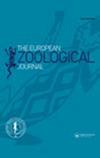Embryonic development of the saccular sensory epithelium in relation to otolith growth in the inner ear of the silver carp, Hypophthalmichthys molitrix (Valenciennes, 1844) (Teleostei: Cyprinidae): light and electron microscopic study
引用次数: 0
Abstract
Abstract The development of the saccular sensory epithelium in the inner ear of the silver carp, Hypophthalmichthys molitrix, was studied from an early stage (2 days after fertilization), when the otic vesicle or otocyst first formed, to the post-larval stage (7 days after hatching), when the development of the inner ear approximates that of the juvenile stage. Light microscopy revealed: (1) the otic vesicle, the primordia of the saccular otolith and the stato-acoustic ganglion were observed by 2 days after fertilization; (2) the saccular macula overlain by a small round otolith is established at 3 days after fertilization, while the utricular macula with its otolith is first observed at 4 days after fertilization; (3) the saccular macula began to differentiate at 3 days after hatching and became well differentiated at 7 days after hatching. At 7 days after hatching, transmission electron microscopy (TEM) revealed: (1) the apical surface of each hair cell is covered with a ciliary bundle formed of a long kinocilium and a short bundle of stereocilia. The supporting cells are provided with microridges on their apical surface and seemed to be covered with small and large vesicles, suggesting that they have a secretory function beside the supporting one; (2) secretory materials such as multivesicular bodies, electron dense granules, empty vesicles and cytoplasmic extrusions are observed scattering over the saccular sensory epithelium, which probably contribute to the formation of the otolith and/or otolithic membrane. Using scanning electron microscopy (SEM), two types of hair bundles are distinguished: the first type consisted of numerous short stereocilia and a kinocilium; the second type has a small number of short stereocilia with a very long kinocilium. Most of these results are discussed with special regard to the environmental factors affecting the early development of the inner ear in teleost fishes.鲢鱼(Hypophthalmichthys molitrix, valciennes, 1844)内耳耳石生长与囊状感觉上皮的胚胎发育:光镜和电镜研究
摘要本文研究了鲢鱼(Hypophthalmichthys molitrix)内耳囊状感觉上皮的发育情况,从受精后2天,即耳囊或耳囊形成的早期阶段,到孵化后7天,即内耳发育接近幼鱼阶段。光镜显示:(1)受精后2天观察到耳小泡、囊状耳石原基、静声神经节;(2)受精后第3天出现小圆形耳石覆盖的囊状黄斑,受精后第4天出现带耳石的胞状黄斑;(3)囊状黄斑在孵化后3天开始分化,在孵化后7天分化良好。在孵化后第7天,透射电子显微镜(TEM)显示:(1)每个毛细胞的顶端表面覆盖着由长纤毛和短纤毛组成的纤毛束。支撑细胞顶端表面有微脊,表面似乎覆盖着大大小小的囊泡,说明除了支撑细胞外,它们还具有分泌功能;(2)多泡体、电子致密颗粒、空泡和细胞质挤出物等分泌物质散布在囊状感觉上皮上,这可能有助于耳石和/或耳石膜的形成。利用扫描电子显微镜(SEM)可以区分出两种类型的毛束:第一种类型由许多短的立体纤毛和kinocillum组成;第二种类型有少量短的立体纤毛和很长的运动纤毛。这些结果大多讨论了影响硬骨鱼内耳早期发育的环境因素。
本文章由计算机程序翻译,如有差异,请以英文原文为准。
求助全文
约1分钟内获得全文
求助全文

 求助内容:
求助内容: 应助结果提醒方式:
应助结果提醒方式:


